Teramind has long been a benchmark for employee monitoring because it combines screen recordings, violation alerts, and deep productivity analytics. Yet in 2025 many companies are looking for a Teramind alternative: some want to cut licensing costs, others dislike heavy-handed oversight, and remote teams simply need time tracking without a screenshot of every keystroke. In this review we explore ten current solutions that help track performance without sacrificing trust.
We pay special attention to Worksection — a project-management platform with a transparent time tracker and clear pricing: every feature is included in the base plan, with no extra dollars or euros for “premium.” You will see how different tools handle employee monitoring, time tracking, and security; a comparison table; and practical tips for choosing a “Teramind replacement.”
Why Do Users Look for Teramind Alternatives?
Teramind offers a powerful toolkit: keystroke capture, screen video, USB-drive control, and automatic DLP policies. But that same power often turns into a drawback when trust and comfort are at stake. First, excessive employee monitoring raises legal and ethical issues: in the EU and several U.S. states you must explicitly notify staff, which complicates deployment. Second, the company pays not only for licenses (from \$10 per user per month on an annual contract) but also for server resources and IT time. Third, the interface is overloaded with security options yet lacks a simple “one-click” time tracker. Fourth, role flexibility is limited: managers sometimes need extra rights just to open reports. Finally, in 2025 transparency and psychological comfort matter more than ever — especially for remote teams that accept time tracking but not total surveillance.
Criteria for Choosing a Teramind Alternative
When selecting a solution, companies balance between time tracking and security. Key benchmarks include:
- Transparency for employees: the clearer a service explains its data collection, the higher the trust level.
- Out-of-the-box reports: the product should generate time sheets, productivity charts, and CSV/XLS exports with no custom templates.
- Auto-tracking with minimal setup: ideally, an agent that starts with system log-in and requires no daily action.
- Data protection: traffic encryption, two-factor authentication, and ISO 27001 data centers reduce risk.
- UX for managers and IT: the easier the rules are to configure, the faster the rollout.
- Team analytics: dashboards by project and role, not just individual scores.
- Flexible licensing: clear pricing in ₽, \$, or € without complicated add-ons for APIs or screenshot history past 30 days.
Top Teramind Alternatives in 2025
Worksection
Worksection stands out because it does not engage in covert surveillance at all. The platform is built around tasks — you create a card, set a deadline, add a checklist, files, and discussions. The time tracker is embedded in each task: click “Start” and the system begins counting minutes. This approach removes tension; the team sees reports on its own actions, not on screenshots. Gantt charts, Kanban boards, and a calendar visually distribute workload. All features are available on every plan: even the most affordable tier at about \$3 per user per month includes the API, client permissions, and unlimited projects. Worksection is therefore a transparent Teramind alternative focused on productivity, not total control.
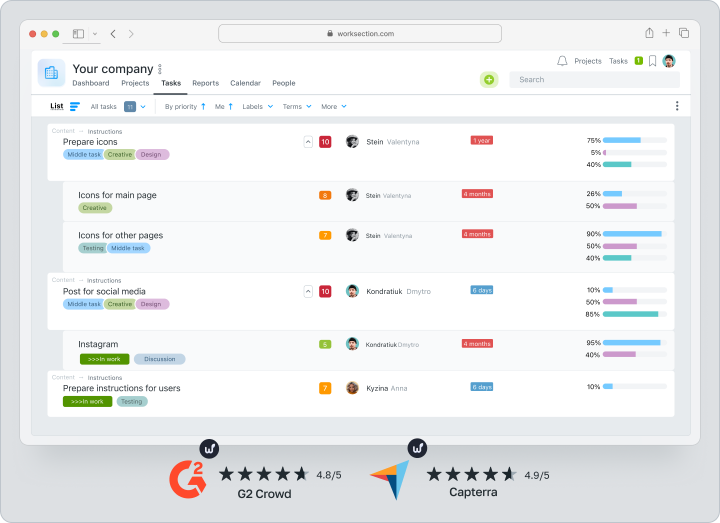
Hubstaff
Hubstaff combines a time tracker, GPS stamps, and periodic screenshots, making it useful for field and remote teams. The service logs keyboard and mouse activity, records offline hours, and generates project reports. Pricing starts at \$4.99 per user per month on an annual plan. Unlike Teramind, the interface is geared toward task management and invoicing rather than DLP. A “blurred screenshots” mode softens privacy concerns.
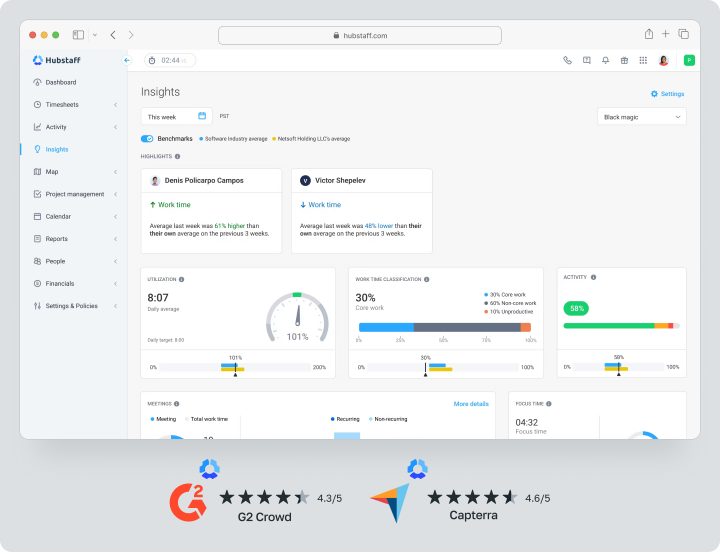
Time Doctor
Time Doctor bridges lightweight tracking and full monitoring. It captures URLs, app titles, takes random screenshots, and sends nudges when a worker loses focus. In 2025 the platform offers AI-driven productivity reports and integrations with Jira, Asana, and Slack. Price: from \$7 a month. Companies needing detailed activity data without full-screen video often choose Time Doctor as a logical Teramind swap.
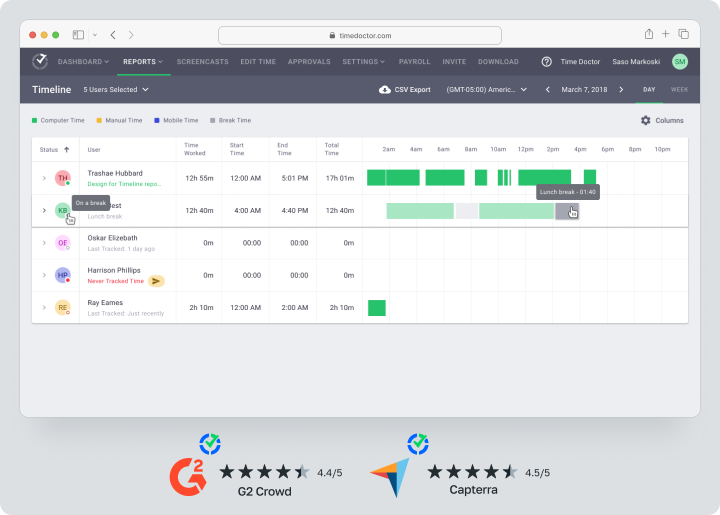
ActivTrak
ActivTrak specializes in behavior analytics: the system classifies sites as “productive” or “distracting,” builds focus heat maps, and detects digital burnout. Screenshots are event-based rather than timed, saving storage and reducing invasiveness. Enterprise pricing starts around \$15. ActivTrak is more about analytics than control, so HR departments of midsize and large companies frequently adopt it.
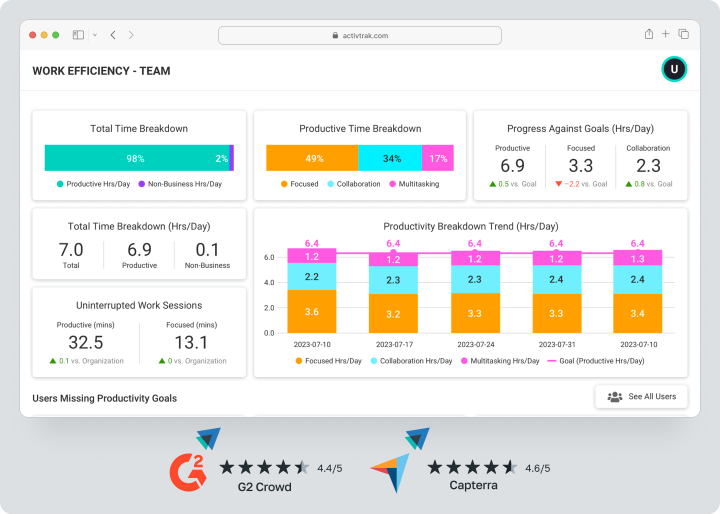
Clockify
Clockify is a free time tracker with an optional paid reporting module (from \$3.99 per month). The agent collects only time logs and URLs, no screenshots. Features include a Pomodoro timer, project cost calculator, and shareable report links — ideal for freelancers and agencies. If you need a Teramind alternative for straightforward time tracking, Clockify does the job at zero cost.
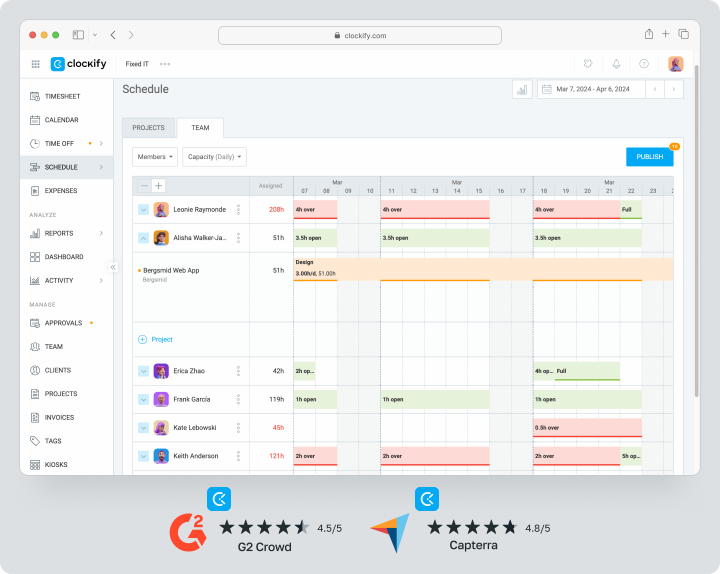
RescueTime
RescueTime focuses on personal productivity. The app analyzes how people allocate time, offers “focus sessions,” and blocks distracting sites. Team reports are available in the Teams plan (from \$6 per user). The service takes no screenshots and stores no sensitive content, lowering privacy worries compared with Teramind.
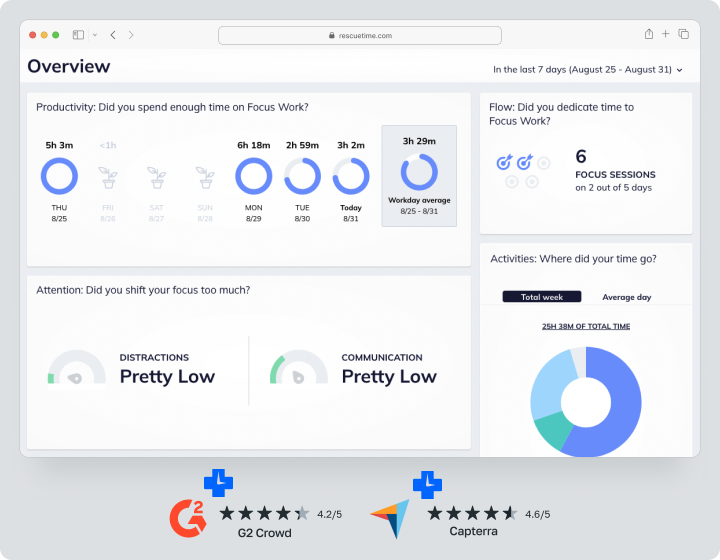
Kickidler
Kickidler is closest to classical employee monitoring: live screen streaming, auto-saving video, and the “Autokid” module that warns of policy breaches. Pricing starts at ₽ 300 per month on a monthly subscription. For security teams needing a Teramind substitute without international payments, Kickidler is a local solution.
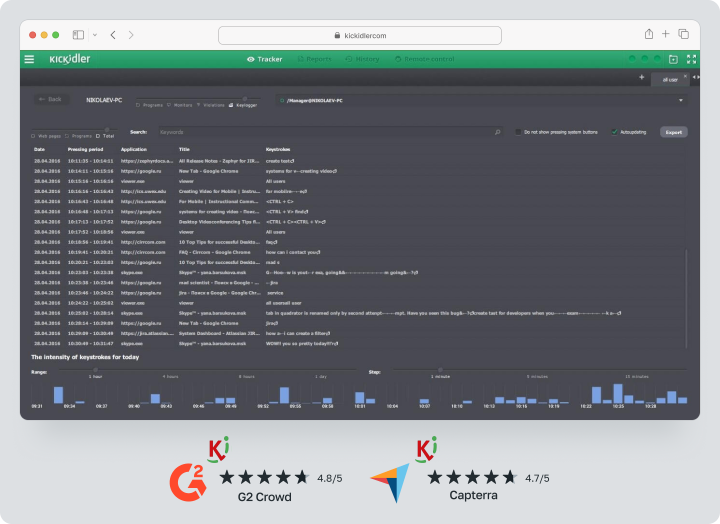
DeskTime
DeskTime automatically detects which programs a user opens and classifies them by productivity. The dashboard shows minute-by-minute activity, overtime, and late arrivals. It includes shift scheduling and project reporting. Price: from €7 a month on yearly billing. DeskTime’s minimal invasion of privacy suits offices seeking a balance of oversight and trust.
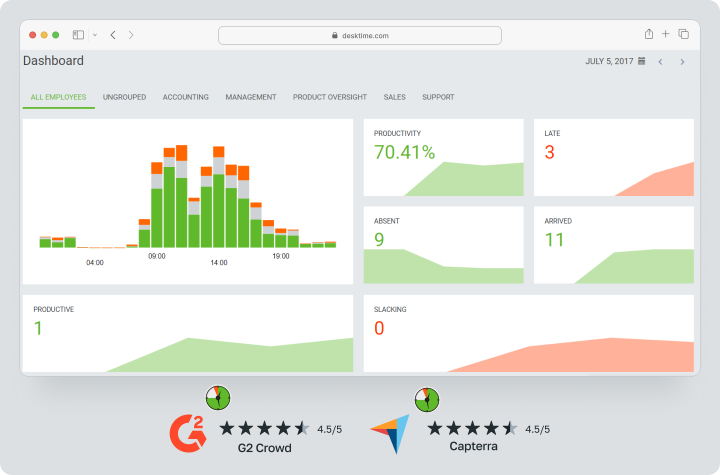
Insightful (formerly Workpuls)
Insightful offers a flexible mix of monitoring and analytics: “Stealth” mode for silent install and “Visible” mode with user notice. AI algorithms display workload, forecast deadlines, and pinpoint bottlenecks. Prices start at \$8 per user. Compared with Teramind, Insightful is easier to deploy and quicker for managers to learn.
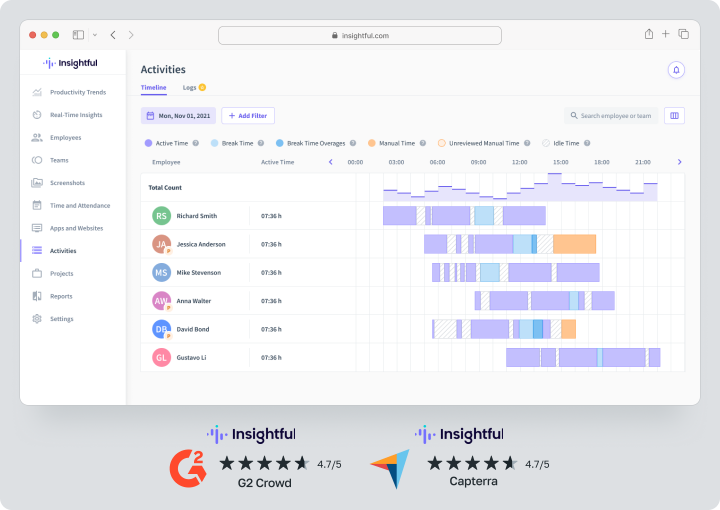
TMetric
TMetric is a lightweight time-tracking solution: a browser “Start” button, cost reports, and integrations with GitLab, Trello, and Visual Studio Code. The free plan covers up to five users; paid tiers start at \$5. It takes no screenshots yet stores full project history. If you need minimal control and maximum reporting, TMetric is a worthy monitoring alternative.
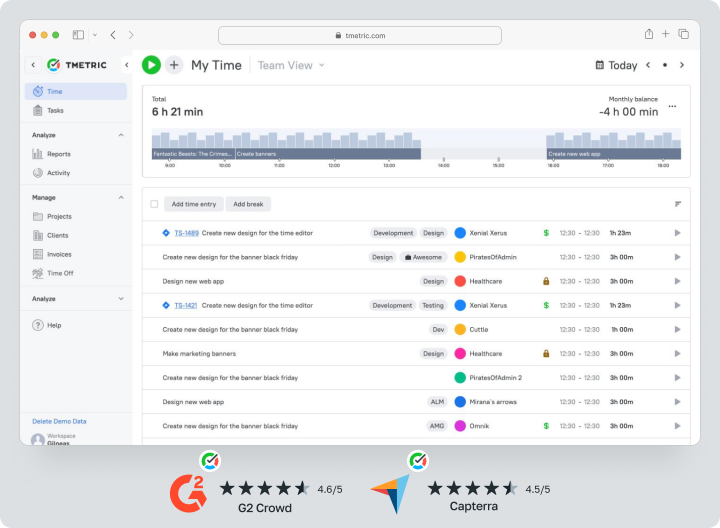
Comparison Table of the Best Teramind Alternatives
| Service | Monitoring Approach | Screenshots / Video | Time Tracker | Reports & Analytics | Price (from) | Ideal For |
| Worksection | Transparent task-based tracking | No | Yes (built-in) | Gantt, Kanban, time sheets, API | ≈ $3 / month | Agencies, product teams |
| Hubstaff | Activity + GPS | Yes (blurred) | Yes | Projects, payroll, invoices | $4.99 | Remote & field teams |
| Time Doctor | Activity + URLs | Yes | Yes | AI focus analysis, distractions | $7 | 50 – 500-person firms |
| ActivTrak | Behavioral analytics | Event-based | Agent | Heat maps, burnout risks | $15 | HR & Enterprise |
| Clockify | Pure tracker | No | Yes | Pomodoro, budgets, exports | $0 | Freelancers, startups |
| RescueTime | Personal productivity | No | Yes | Goals, distraction blocking | $6 | Individual users |
| Kickidler | Full oversight | Real-time video | Yes | Policy violations, keylogging | ₽ 300 | InfoSec teams |
| DeskTime | Auto classification | Timed | Yes | Overtime, shifts, lateness | €7 | Office teams |
| Insightful | Stealth / Visible mix | Yes | Yes | Forecasts, AI dashboards | $8 | Scaling companies |
| TMetric | Simple time log | No | Yes | Rates, reports, integrations | $5 | Developers, outsourcing |
Which Platform Should You Choose in 2025?
If your company truly needs strict control — screenshots and USB-stick alerts — consider Hubstaff or Time Doctor: they offer a “mid-level” of oversight without Teramind’s heavy DLP stack. For delicate time tracking where trust is paramount, Worksection is ideal: no hidden agents, detailed reports, and the same feature set on every tier. Large enterprises wanting deep team analytics often choose ActivTrak or Insightful; both build productivity heat maps and predict burnout risks. And if budget is minimal, look at Clockify or TMetric: baseline tracking is free or nearly free.
Frequently Asked Questions (FAQ)
Which Teramind alternative suits remote teams?
Remote teams prioritize visibility without undue pressure. Hubstaff excels with GPS stamps and activity scores, Time Doctor highlights lost focus, and Worksection offers a transparent time tracker plus task boards, preserving trust across distributed staff.
Are there free Teramind analogues?
Yes. Clockify provides a full free plan with unlimited data retention. TMetric and Worksection also have basic (or trial) tiers that let teams test time tracking and project management without upfront costs.
How is Worksection different from Teramind?
The key difference is philosophy. Worksection is a task-oriented platform with built-in time tracking where employees start the timer themselves and view the results. Teramind is a control system capable of covert screen recording and keystroke logging. If you need time tracking, clear reports, and Kanban boards rather than video surveillance, Worksection is a more ethical and affordable replacement.